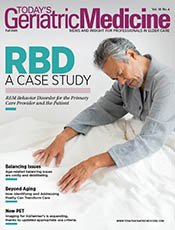
Fall 2025
Fall 2025 Issue Editor’s Note: Determination As we age and our bodies undergo the changes associated with it, there are challenges. Our bones become brittle, our minds aren’t as acute as they once were, and, of course, we become much more susceptible to age-related disorders and diseases. There will be some among this older population who give in to age-related decline, likely figuring what’s the use in fighting what is natural? Others will remain determined to fight back in any way in which they are able. Decades ago, it might not have been as feasible or easy to fight back, but given our longer lifespans and the wide range of technological advancements, battling age-related ailments has gotten easier. This issue highlights key challenges older adults face, and the ways in which modern technological advances and health care discoveries are assisting with the challenges of aging. In our cover feature, James and Carol Siberski delve into rapid eye movement behavior disorder (RBD), a complex sleep disorder that can be particularly devastating to older adults if left untreated. They emphasize the importance of breaking down the stigma around discussing the disorder, which stems from the tendency of those suffering from it to inadvertently hurt their bed partner. Though it may seem difficult, with the right therapeutic treatment, RBD can be treated effectively. Geoffrey Feld and John Ralston discuss rebalancing in their feature, “Balancing Issues.” As adults age, the parts of the inner ear responsible for balance deteriorate, leading to a range of issues such as loss of independence, decrease in quality of life, and chiefly, the inability to balance oneself. Typically, such issues are costly to treat and require invasive surgery. Now, noninvasive, cost-effective treatments are available. Frailty is classified as one of the “Geriatric Giants,” key age-related syndromes that decrease mobility and quality of life in older adults. Frailty could be considered a gateway to many of these other syndromes, given that those who suffer from it likely also suffer from bone fractures, fall risks, and disability. In her feature “Beyond Aging,” Stephanie Dunne explains how frailty can be addressed to prevent further health decline in older adults. Finally, Beth W. Orenstein looks at advances in Alzheimer’s imaging. As our understanding of Alzheimer’s disease expands, our diagnostic techniques must do the same. New radiotracers allow radiologists to catch the development of the plaque that causes Alzheimer’s much sooner, leading to better health outcomes. Enjoy the issue. — Josh Hildebrand |
